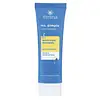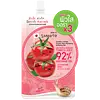What's inside
What's inside
 Key Ingredients
Key Ingredients

 Benefits
Benefits

 Concerns
Concerns

 Ingredients Side-by-side
Ingredients Side-by-side

Water
Skin ConditioningEthylhexyl Methoxycinnamate
UV AbsorberPropylene Glycol
Humectant4-Methylbenzylidene Camphor
UV AbsorberAcrylates Copolymer
Dimethicone
EmollientPolyacrylamide
Cyclopentasiloxane
EmollientButylene Glycol
HumectantBenzyl Alcohol
PerfumingPanthenol
Skin ConditioningTriethanolamine
BufferingC13-14 Isoparaffin
EmollientPolysorbate 60
EmulsifyingEthylhexylglycerin
Skin ConditioningParfum
MaskingAloe Barbadensis Leaf Extract
EmollientEpilobium Angustifolium Extract
Skin ConditioningLaureth-7
EmulsifyingBeta-Glucan
Skin ConditioningCarbomer
Emulsion StabilisingTitanium Dioxide
Cosmetic ColorantTocopheryl Acetate
AntioxidantDimethicone Crosspolymer
Emulsion StabilisingDimethicone/Vinyl Dimethicone Crosspolymer
Skin ConditioningPhenoxyethanol
PreservativeDimethiconol
EmollientSodium Metabisulfite
AntioxidantHamamelis Virginiana Extract
AntiseborrhoeicPotassium Sorbate
PreservativeSodium Benzoate
MaskingTocopherol
AntioxidantWater, Ethylhexyl Methoxycinnamate, Propylene Glycol, 4-Methylbenzylidene Camphor, Acrylates Copolymer, Dimethicone, Polyacrylamide, Cyclopentasiloxane, Butylene Glycol, Benzyl Alcohol, Panthenol, Triethanolamine, C13-14 Isoparaffin, Polysorbate 60, Ethylhexylglycerin, Parfum, Aloe Barbadensis Leaf Extract, Epilobium Angustifolium Extract, Laureth-7, Beta-Glucan, Carbomer, Titanium Dioxide, Tocopheryl Acetate, Dimethicone Crosspolymer, Dimethicone/Vinyl Dimethicone Crosspolymer, Phenoxyethanol, Dimethiconol, Sodium Metabisulfite, Hamamelis Virginiana Extract, Potassium Sorbate, Sodium Benzoate, Tocopherol
Solanum Lycopersicum Fruit Water
MaskingWater
Skin ConditioningNiacinamide
SmoothingButylene Glycol
HumectantYogurt Powder
Sodium Ascorbyl Phosphate
AntioxidantSnail Secretion Filtrate
Skin ConditioningSodium Hyaluronate
HumectantPhenoxyethanol
PreservativeTriethanolamine
BufferingTocopheryl Acetate
AntioxidantParfum
MaskingCollagen
MoisturisingGlutathione
Carbomer
Emulsion StabilisingAllantoin
Skin ConditioningChlorphenesin
AntimicrobialDisodium EDTA
CI 77891
Cosmetic ColorantCI 16255
Cosmetic ColorantSolanum Lycopersicum Fruit Water, Water, Niacinamide, Butylene Glycol, Yogurt Powder, Sodium Ascorbyl Phosphate, Snail Secretion Filtrate, Sodium Hyaluronate, Phenoxyethanol, Triethanolamine, Tocopheryl Acetate, Parfum, Collagen, Glutathione, Carbomer, Allantoin, Chlorphenesin, Disodium EDTA, CI 77891, CI 16255
Ingredients Explained
These ingredients are found in both products.
Ingredients higher up in an ingredient list are typically present in a larger amount.
Butylene Glycol (or BG) is used within cosmetic products for a few different reasons:
Overall, Butylene Glycol is a safe and well-rounded ingredient that works well with other ingredients.
Though this ingredient works well with most skin types, some people with sensitive skin may experience a reaction such as allergic rashes, closed comedones, or itchiness.
Learn more about Butylene GlycolCarbomer is a polymer of acrylic acid. Its main role is to create a gel consistency.
A high amount of carbomer can cause pilling or balling up of products. Don't worry, most products contain 1% or less of carbomer.
Parfum is a catch-all term for an ingredient or more that is used to give a scent to products.
Also called "fragrance", this ingredient can be a blend of hundreds of chemicals or plant oils. This means every product with "fragrance" or "parfum" in the ingredients list is a different mixture.
For instance, Habanolide is a proprietary trade name for a specific aroma chemical. When used as a fragrance ingredient in cosmetics, most aroma chemicals fall under the broad labeling category of “FRAGRANCE” or “PARFUM” according to EU and US regulations.
The term 'parfum' or 'fragrance' is not regulated in many countries. In many cases, it is up to the brand to define this term.
For instance, many brands choose to label themselves as "fragrance-free" because they are not using synthetic fragrances. However, their products may still contain ingredients such as essential oils that are considered a fragrance by INCI standards.
One example is Calendula flower extract. Calendula is an essential oil that still imparts a scent or 'fragrance'.
Depending on the blend, the ingredients in the mixture can cause allergies and sensitivities on the skin. Some ingredients that are known EU allergens include linalool and citronellol.
Parfum can also be used to mask or cover an unpleasant scent.
The bottom line is: not all fragrances/parfum/ingredients are created equally. If you are worried about fragrances, we recommend taking a closer look at an ingredient. And of course, we always recommend speaking with a professional.
Learn more about ParfumPhenoxyethanol is a preservative that has germicide, antimicrobial, and aromatic properties. Studies show that phenoxyethanol can prevent microbial growth. By itself, it has a scent that is similar to that of a rose.
It's often used in formulations along with Caprylyl Glycol to preserve the shelf life of products.
Tocopheryl Acetate is AKA Vitamin E. It is an antioxidant and protects your skin from free radicals. Free radicals damage the skin by breaking down collagen.
One study found using Tocopheryl Acetate with Vitamin C decreased the number of sunburned cells.
Tocopheryl Acetate is commonly found in both skincare and dietary supplements.
Learn more about Tocopheryl AcetateTriethanolamine is an emulsifier and pH adjuster. It is created using ethylene oxide and ammonia. This gives Triethanolamine a nitrogen core and a similar scent to ammonia.
As an emulsifier, it prevents ingredients from separating and enhances texture by adding volume to a product.
PH adjusters are common in cosmetic products. The pH of a product can affect the effectiveness of other ingredients. A product with a high pH may also irritate the skin.
Learn more about TriethanolamineWater. It's the most common cosmetic ingredient of all. You'll usually see it at the top of ingredient lists, meaning that it makes up the largest part of the product.
So why is it so popular? Water most often acts as a solvent - this means that it helps dissolve other ingredients into the formulation.
You'll also recognize water as that liquid we all need to stay alive. If you see this, drink a glass of water. Stay hydrated!
Learn more about Water